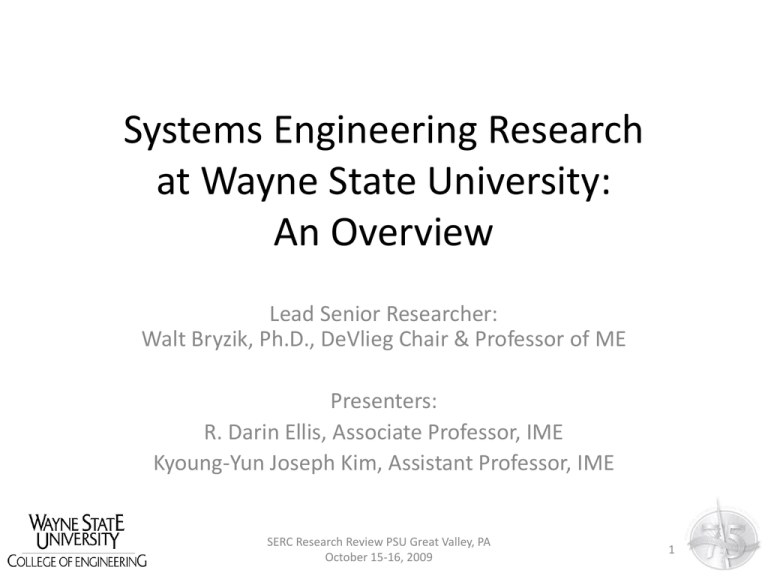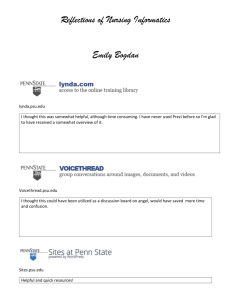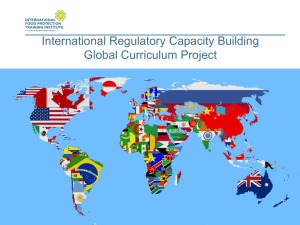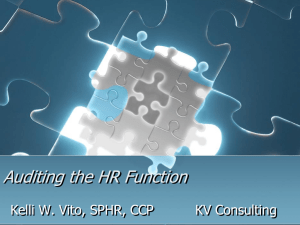Wayne State University - Systems Engineering Research Center
advertisement

Systems Engineering Research at Wayne State University: An Overview Lead Senior Researcher: Walt Bryzik, Ph.D., DeVlieg Chair & Professor of ME Presenters: R. Darin Ellis, Associate Professor, IME Kyoung-Yun Joseph Kim, Assistant Professor, IME SERC Research Review PSU Great Valley, PA October 15-16, 2009 1 Background • Wayne State University – University Research Corridor – In Detroit, the “Arsenal of Democracy” • Major customer/stakeholders – TARDEC & TACOM (all Army ground vehicles) – Defense Contractors (e.g. General Dynamics) – Domestic Auto Industry • TARDEC & TACOM responding to SE revitalization – WSU’s SE efforts build on long relationship with TARDEC & TACOM SERC Research Review PSU Great Valley, PA October 15-16, 2009 2 Army Ground Vehicle SE Concerns Applications New Vehicles & Upgrades Net-centric Ops Robotic & Manned Vehicles Combat, Tactical & Support Functions Attributes Crew Health & Safety Power & Energy Deployability Sustainability Mobility Survivability C4ISR Lethality SERC Research Review PSU Great Valley, PA October 15-16, 2009 Endurance Capacity Reliability Maintainability 3 Systems Engineering Revitalization at TARDEC Life Cycle SE To Predict and Manage • Cost • Risk • Schedule • Performance Methods, Tools & Processes (MTP) SE Revitalization • Training • Organization • Corporate culture • Institutionalization • New MTP Adapt & Transfer for Ground Vehicles TARDEC SE and SE Support to TACOM SE Center at WSU SE Research UARC Issues, Opportunities & Effectiveness Experience “In the Trenches” SERC Research Review PSU Great Valley, PA October 15-16, 2009 4 SER UARC Research Strategy Thrusts • Enterprise Responsiveness – Explore advancements in SE MPTs that are responsive to enterprise strategic and program-level needs, – Enable agility and responsiveness during program conceptualization, execution, strategic choice & assessment. – Support cross-system and enterprise decisions. • Systems Science and Complexity – Advance systems science and systems thinking for application to engineering and management of complex systems and capabilities. – Support systems engineering and management of complex systems, SoS, software-focused, & net-centric. • SE Workforce – Explore future SE workforce competencies – Explore approaches to cultivate, educate, and prepare the future SE workforce. – Consider the nature of the environment, system types, and changes in SE MPTs with respect to competencies. • Program Management and SE Integration – Promote and integrate SE methods, processes, and tools with program execution activities within all aspects of program management to include political issues, cost issues, all other PM tools. – Communicate the effectiveness of SE to leadership and PMs so that there will be increased usage of SE. • Life Cycle Systems Engineering Processes – Advance system engineering life cycle technical and management processes. – Mature and Advance fundamental systems engineering technical and technical management processes. – Evolve fundamentals to consideration security, information age tools, and lean principles. SERC Research Review PSU Great Valley, PA October 15-16, 2009 5 WSU Systems Engineering Research Thrusts • Enterprise Responsiveness Ground Vehicle – Explore advancements in SE MPTs that are responsive to enterprise strategic and program-level needs, Power and choice Energy Systems – Enable agility and responsiveness during program conceptualization, execution, strategic & assessment. – Support cross-system and enterprise decisions. (Bryzik & Henein) • Systems Science and Complexity – Advance systems science and systems thinking for application to engineering and management of complex systems and capabilities. – Support systems engineering and management of complex systems, SoS, software-focused, & net-centric. • SE Workforce – Explore future SE workforce competencies – Explore approaches to cultivate, educate, and prepare the future SE workforce. Detection of SOC and – Consider the nature of the environment, system types, and changes in SE MPTs with respect to competencies. Mode of injection using Ion Current Signal • Program Management and SE Integration – Promote and integrate SE methods, processes, and tools with program execution activities within all aspects of program management to include political issues, cost issues, all other PM tools. Rate of heat – Communicate the effectiveness of SE to leadership and PMs so that there will be increased usage of SE. release vs IMEP • Life Cycle Systems Engineering Processes – Advance system engineering life cycle technical and management processes. – Mature and Advance fundamental systems engineering technical and technical management processes. – Evolve fundamentals to consideration security, information age tools, and lean principles. SERC Research Review PSU Great Valley, PA October 15-16, 2009 6 WSU Systems Engineering Research Thrusts • Enterprise Responsiveness Rapid HFE – Explore advancements in SE MPTs that are responsive to enterprise strategic and program-level needs, & choice Evaluation – Enable agility and responsiveness during program conceptualization, execution,Test strategic & assessment. – Support cross-system and enterprise decisions. to Support HSI in Technology Development Projects Advance systems science and systems thinking for application to engineering and management of complex systems and • Systems Science and Complexity – capabilities. – Support systems engineering and management of complex systems, SoS, software-focused, & net-centric. (Ellis & Witus) • SE Workforce – Explore future SE workforce competencies – Explore approaches to cultivate, educate, and prepare the future SE workforce. – Consider the nature of the environment, system types, and changes in SE MPTs with respect to competencies. • Program Management and SE Integration – Promote and integrate SE methods, processes, and tools with program execution activities within all aspects of program management to include political issues, cost issues, all other PM tools. – Communicate the effectiveness of SE to leadership and PMs so that there will be increased usage of SE. • Life Cycle Systems Engineering Processes – Advance system engineering life cycle technical and management processes. – Mature and Advance fundamental systems engineering technical and technical management processes. – Evolve fundamentals to consideration security, information age tools, and lean principles. SERC Research Review PSU Great Valley, PA October 15-16, 2009 7 WSU Systems Engineering Research Thrusts • Enterprise Responsiveness Top Deck Deconfliction: – Explore advancements in SE MPTs that are responsive to enterprise strategic and program-level needs, Vehicle KPPchoice Requirements – Enable agility and responsiveness during program conceptualization, execution, strategic & assessment. – Support cross-system and enterprise decisions. Management through Systems Integration & Optimization Advance systems science and systems thinking for application to engineering and management complex systems and (Chinnam &ofMurat) • Systems Science and Complexity – capabilities. – Support systems engineering and management of complex systems, SoS, software-focused, & net-centric. • SE Workforce – Explore future SE workforce competencies – Explore approaches to cultivate, educate, and prepare the future SE workforce. – Consider the nature of the environment, system types, and changes in SE MPTs with respect to competencies. • Program Management and SE Integration – Promote and integrate SE methods, processes, and tools with program execution activities within all aspects of program management to include political issues, cost issues, all other PM tools. Evaluate Top-Deck Overall Utility – Communicate the effectiveness of SE to leadership and PMs so that there will be increased usage of SE. • Life Cycle Systems Engineering Processes – Advance system engineering life cycle technical and management processes. – Mature and Advance fundamental systems engineering technical and technical management processes. – Evolve fundamentals to consideration security, information age tools, and lean principles. SERC Research Review PSU Great Valley, PA October 15-16, 2009 8 WSU Systems Engineering Research Thrusts • Enterprise Responsiveness – Explore advancements in SE MPTs that are responsive to enterprise strategic and program-level needs, – Enable agility and responsiveness during program conceptualization, choice & assessment. SEexecution, Tools strategic for Effective Deployment – Support cross-system and enterprise decisions. • Systems Science and Complexity of Condition-Based Maintenance and Performance Based Logistics – Advance systems science and systems thinking for application to engineering and management of complex systems and capabilities. (Chinnam&&net-centric. Murat) – Support systems engineering and management of complex systems, SoS, software-focused, • SE Workforce – Explore future SE workforce competencies – Explore approaches to cultivate, educate, and prepare the future SE workforce. – Consider the nature of the environment, system types, and changes in SE MPTs with respect to competencies. • Program Management and SE Integration – Promote and integrate SE methods, processes, and tools with program execution activities within all aspects of program management to include political issues, cost issues, all other PM tools. – Communicate the effectiveness of SE to leadership and PMs so that there will be increased usage of SE. • Life Cycle Systems Engineering Processes – Advance system engineering life cycle technical and management processes. – Mature and Advance fundamental systems engineering technical and technical management processes. – Evolve fundamentals to consideration security, information age tools, and lean principles. SERC Research Review PSU Great Valley, PA October 15-16, 2009 9 WSU Systems Engineering Research Thrusts • Enterprise Responsiveness Sustainable System – Explore advancements in SE MPTs that are responsive to enterprise strategic and program-level needs, – Enable agility and responsiveness during program conceptualization, execution, strategic choice & assessment. Information Management – Support cross-system and enterprise decisions. (SE Informatics): • Systems Science and Complexity Causal Knowledge – Advance systems science and systems thinking for application to engineeringRepresentation and management of&complex systems and Analysis capabilities. – Support systems engineering and management of complex systems, SoS, software-focused, & net-centric. Rough Set-Based Semantic Rule Complexity Reduction • SE Workforce – Explore future SE workforce competencies – Explore approaches to cultivate, educate, and prepare the future SE workforce. (Kim) – Consider the nature of the environment, system types, and changes in SE MPTs with respect to competencies. • Program Management and SE Integration – Promote and integrate SE methods, processes, and tools with program execution activities within all aspects of program management to include political issues, cost issues, all other PM tools. – Communicate the effectiveness of SE to leadership and PMs so that there will be increased usage of SE. • Life Cycle Systems Engineering Processes – Advance system engineering life cycle technical and management processes. – Mature and Advance fundamental systems engineering technical and technical management processes. – Evolve fundamentals to consideration security, information age tools, and lean principles. SERC Research Review PSU Great Valley, PA October 15-16, 2009 10 Causal Knowledge Representation and Analysis • Current limitations of knowledge systems in systems development & acquisition • Causal Knowledge network • Causal knowledge representation by SysML • Degree of Causal Representation (DCR) is a causal representation measure, which is combined with – Causality (C), Network Connectivity (NC), Weighted Network Connectivity (WNC) Probability Comparison Recursion of O(n2) SERC Research Review PSU Great Valley, PA October 15-16, 2009 11 Rough set based semantic rule complexity reduction • Incomplete information and • Intensive design knowledge in complexity issues collaborative environment • Efficient design rule management methodology required owl:Thing Individual Product Material Feature Part Assembly FeatureForVisualization Shape SpatialRelationship FusionWeldin IndexedFace Appearance AppearanceColor AppearanceTexture FeatureForPart GeometricFeature FormFeature FeatureForAssembly AssemblyFeature JointFeature MatingFeature MatingBond JointFeatureCharacteristics JoiningConstraint JoiningTolerance JointConfiguration ContactShape Manufacturing DegreesOfFreedom ManufacturingProcess JoiningProcess Against Aligned InclineOffset IncludeAngle ParallelOffset ParaxOffset SRDirection FusionWeldingCondition AdhesiveBondingCondition BrazingCondition MechanicalFasteningCondition RivetingCondition CompressionCondition MetalStitchingCondition CrimpingCondition SnapInCondition PushOnCondition SpotWeldingCondition SolderingCondition FixtureLocation FillerMetal Gas ElectricalSpecation GMAW GTAW FCAW SMAW PAW Fixed Lin Plan Rot AdhesiveBonding Brazing MechanialFasteningThreadedFastener MechanialFasteningRivet Compression MetalStitchingStapling Crimping SnapIn PushOnFastener SpotWelding Soldering ButtJoint ConerJoint TJoint WeldConfiguration LapJoint AdhesiveBondConfiguration MechanicalFastenerConfiguration RivetConfiguration StapleConfiguration SolderConfiguration Colinear Cylindrical Plane Spherical • Minimal design rule selection SERC Research Review PSU Great Valley, PA October 15-16, 2009 Rule 1 3 5 7 If (f2=31) (f4=0) (f6=1) (f9=0) Then d=1 d=1 d=1 d=1 Rule 2 4 6 If (f3=1) (f5=1) (f7=1)∧(f8=1) Then d=1 d=1 d=1 12 WSU Systems Engineering Research Thrusts • Enterprise Responsiveness – Explore advancements in SE MPTs that are responsive to enterprise strategic and program-level needs, – Enable agility and responsiveness during program conceptualization,Socio-Cultural execution, strategic choice & assessment. Technical Systems – Support cross-system and enterprise decisions. • Systems Science and Complexity Roadmap for Implementing IPD Teams – Advance systems science and systems thinking for application to engineering and management of complex systems and capabilities. (Gluesing) – Support systems engineering and management of complex systems, SoS, software-focused, & net-centric. • SE Workforce – Explore future SE workforce competencies – Explore approaches to cultivate, educate, and prepare the future SE workforce. – Consider the nature of the environment, system types, and changes in SE MPTs with respect to competencies. • Program Management and SE Integration – Promote and integrate SE methods, processes, and tools with program execution activities within all aspects of program management to include political issues, cost issues, all other PM tools. – Communicate the effectiveness of SE to leadership and PMs so that there will be increased usage of SE. • Life Cycle Systems Engineering Processes – Advance system engineering life cycle technical and management processes. – Mature and Advance fundamental systems engineering technical and technical management processes. – Evolve fundamentals to consideration security, information age tools, and lean principles. SERC Research Review PSU Great Valley, PA October 15-16, 2009 13 SE Workforce Development: Key Issues for WSU • SE is growing in MI Graduate Certificate – Government (DoD, NASA) – Contractors (GDLS, BAE, SAIC) • SE/IME 6840 Project Management • SE/IME 7995 Systems Engineering • SE/IME 7720 Engineering Risk and Decision Analysis • SE/IME 7998 Engineering Management and Leadership Customer-focused approach – Tight integration with stakeholders – Need options for offerings (Grad Certificate leading to MS) – Need “SE” brand, not just “engineering management” • • Build on successes – Engineering Management onsite program at Ford – Use existing coursework where possible – Enrich with case studies from local partners (TACOM/TARDEC, GDLS) SERC Research Review PSU Great Valley, PA October 15-16, 2009 14 End Questions? SERC Research Review PSU Great Valley, PA October 15-16, 2009 15







